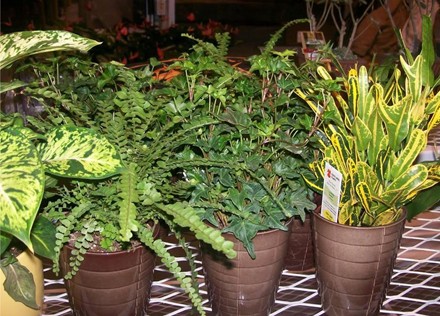Tips for Tropicals
By Jos Van Hage

Many people enjoy having tropical plants inside their home and there are some general instructions to keep plants looking good year round. Light is an important factor and not all plants have the same light requirements. It is important to choose the right plant for the right location so if you have a south facing window that receives a minimum of 4-5 hours of direct sunlight every day choose a plant that requires full sun. Other plants may only require low light which would be a location well away from a window with enough light to be able to read a book.
Many tropical plants are killed by either too much or too little water. Generally it is better to give a good thorough watering every once in a while, rather than water the plant daily with just a little bit of water each time. Conditions vary as to time of year, location, size of plant or pot, etc. so you cannot water a plant on a schedule but rather when the plant needs the water. We suggest that when the soil begins to dry out give the plant a thorough water using warm (room temperature) water and then drain any excess water that still remains after an hour from being watered. If the soil is kept too soggy the plants roots are unable to absorb the moisture and in turn displaces the oxygen which will cause the roots to suffocate and eventually rot. Too little water will dry out the plants roots and then will affect the foliage but most plants are killed by too much water.
Most tropical plants enjoy normal room temperatures of 18-22 Celsius and are not bothered if temperatures go down a few degrees at night. You need to keep plants away from drafts, heaters, outside doors and when outside temperatures get very cold take plants out of the window sills as these can become quite cold. Many plants enjoy normal/high humidity and in the winter the humidity can get low in our homes. The humidity can be raised by choosing a saucer one size larger than the pot size of the plant and filling the saucer with rock and then with water to just below the surface of the rocks. Place the potted plant on top of the rock/water filled saucer making sure that the bottom of the pot is not touching the water so that the plant is not able to take up any water from the saucer. As the water evaporates it will raise the humidity level around the plant.
Fertilizer provides plants the needed nutrients for healthy growth. In the winter months when plants go semi-dormant they do not require very much fertilizer because they are not very active so they should be fertilized once every 8-10 weeks. In the spring/summer months when they are actively growing they can be fertilized every 4-6 weeks. Use a well-balanced, good quality, fertilizer such as 20-20-20.
Transplanting is only needed when a plant has outgrown its pot. Some signs may be that the soil dries out quickly, the plants growth is slowing down during the spring/summer, roots are growing through the drainage hole, and when the plant is taken out of the pot the roots are massed along the outside and there is not a lot of soil visible. When it comes time to re-pot a plant choose a pot that is one size larger than the one the plant is currently in, there has to be good drainage and use a good quality indoor potting soil.
-Jos
Jos Van Hage owns and operates two Art Knapp Home and Garden Centres in Prince George:
-
Highway 16 West at Kimball Road
-
Highway 97 North at Northwood Pulpmill Road
Previous Story - Next Story
Return to Home








